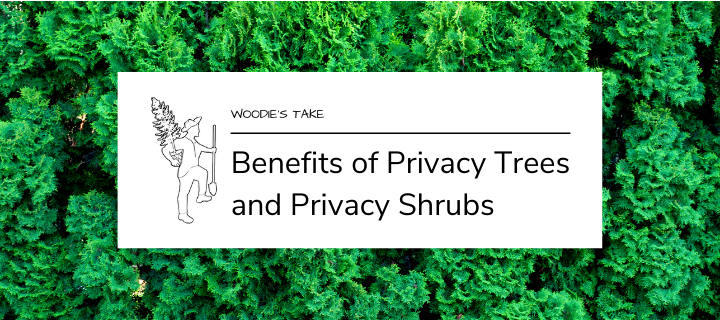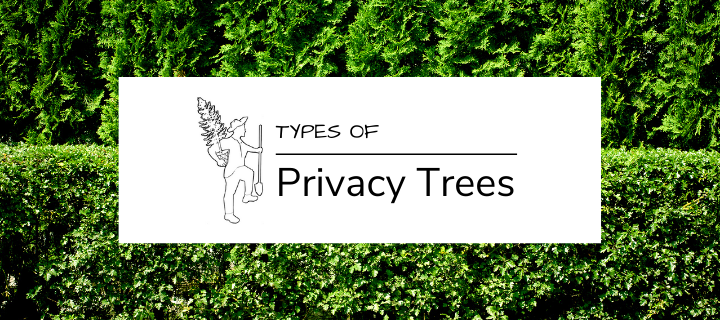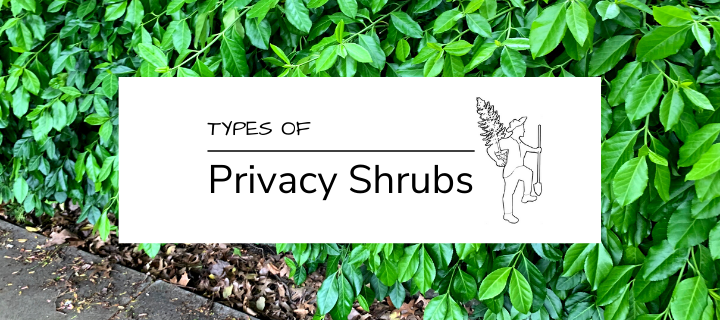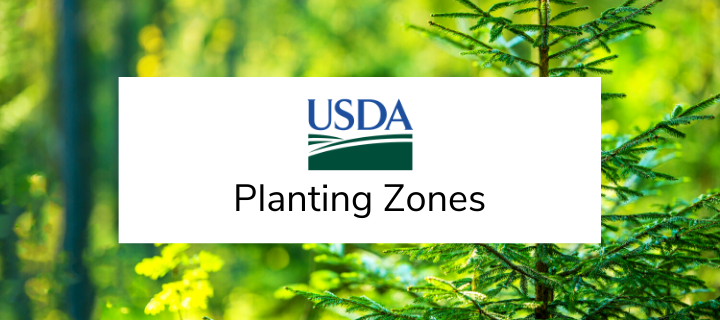Choosing the Best Screening Trees and Shrubs for Your Property
From straight rows to clusters, privacy screens are the perfect accessory to landscaping designs. They provide numerous benefits to landscaping and the environment and can be customized to fit a design feel. Depending on preference, they can be composed of trees, shrubbery, or both and can include the type of plants that best fit the geographic location, desired maintenance level, and aesthetic appeal.

Benefits of Privacy Trees and Privacy Shrubs
Besides their visual appeal, privacy trees and shrubs are assets to include in landscaping designs. They serve as a buffer between the yard and the surrounding area’s sights and sounds, and many landscapers use them to establish a boundary line. In particular, privacy trees are used as windbreaks especially in rural areas. Privacy trees provide shade to shrubbery and flowers while privacy shrubs provide shade to smaller shrubbery and flowers.
Adding texture and color to landscape design is important because privacy trees and shrubbery serve a dual purpose of acting as a buffer while creating visual appeal. In addition, privacy trees are beneficial to the environment because they help clean the air by absorbing carbon dioxide, and both privacy trees and shrubbery stimulate a better growing environment for other landscaping elements.

Types of Privacy Trees
Trees that are used for privacy have a dense growth of needles or leaves, with branches that often reach down to the ground. While privacy trees include a variety of options, they typically include evergreens and have columnar, pyramidal, fastigiate or round habits.
-
Arborvitae
Typically used as windbreaks, Arborvitae trees are known for being resilient and easy to grow. As evergreen trees, they have a range of growth rates and only need to be trimmed to coincide with the landscaping design. In an urban area, the Arborvitae Emerald Green is ideal because of its slower growth rate and compact size, and in a larger space, the Thuja Green Giant is suitable because of its larger size and the ability to withstand higher wind speeds. -
Cedar
With their barrel-shape, cedars are large conifers that can tolerate many types of soil and have a long lifespan. They grow vertically as well as horizontally if they are given enough space. One of the most common types of cedars is the Eastern Red Cedar, and as the foliage turns, its foliage ranges from dark blue to green to bronze. Cedar trees are common alongside roadways because they can flourish in almost any soil type despite elements added to the soil (ex. salt during the winter). -
Cryptomeria
Known as the Japanese Cedar, cryptomeria is not part of the cedar tree family. With a narrow growth up to 100 feet, cryptomeria is recognized for its height and droopy branches with scaly, dark green needles. With cones small and round, the tree has reddish, fibrous, exfoliating bark, and in some varieties, the needles are feathery and turn a beautiful bronze-red in autumn. Cryptomeria trees flourish in environments with damp soil. -
Cypress
With round branchlets, cypress trees are often pyramidal or fastigiate, which means they have a tall habit with the branches nearly parallel to each other. Famous for its thin, columnar habit and dark green needles, the Italian Cypress is successful in warm climates. Used for dense privacy screens and windbreaks, Leyland Cypress is one of the fastest growing privacy trees that you can choose for your outdoor space. -
Holly
Reaching over 20 feet in height, holly trees are dioecious, which means they are either female or male. Since the trees are also grown for their berries, it’s necessary to plant males and females together most of the time. However, some varieties of female holly bear seedless fruit without being pollinated. Some species of holly have golden berries, and others have leaves with splotches of yellow or leaves that are attractively edged in yellow. American Holly Trees make ideal privacy hedges for their large pyramidal shape and ability to remain a lush green year-round. -
Juniper
These evergreens have small, narrow, sharp leaflets and a spreading or upright habit. On some juniper trees, the female cones are edible and resemble blackberries, and the bark is reddish and full of resin. Junipers flourish in alkaline soils and are easy to grow from cuttings or seeds. Common juniper varieties have attractive, exfoliating bark and awl-shaped, needle-like leaves and typically have a columnar shape. -
Pine
With over 35 pine species in North America, they are ideal trees for privacy screens. Younger pines tend to be more conical in shape, but older pines, whose upper branches tend to have a horizontal spread, have their own beauty and value. Planted in direct sunlight, pines thrive in well-drained soil that is not overly rich. Full of resin, most have bark composed of furrows, and some species have striking reddish bark. The needles of the pine can help distinguish the species because needle growth differs in their groupings, and the cones come in many sizes and can be vertical or horizontal. -
Spruce
Spruce trees tend to have a conical habit and cones that hang down from the branches. When the needles have fallen off the branches, they leave interesting projections that resemble pegs. Spruces do best in cold, somewhat humid climates. One of the most recognized trees is the Norway Spruce because it often used as the quintessential Christmas tree. Another popular choice is the Baby Blue Spruce because of its slow growth and blue foliage.

Types of Privacy Shrubs
For privacy screens that need to be shorter or need a variety of heights, shrubbery is beneficial to include in landscaping designs. Shrubbery adds different textures, heights, and colors than only using privacy trees.
-
Barberry
Either deciduous or evergreen, Barberries are famous for their yellow or red leaves, and they are easy to grow and thrive in a wide range of soils and light levels. -
Boxwood
With heights from 2 to 20 feet tall, Boxwood shrubs have a long lifespan and very small leaves that add texture to any privacy screen. -
Cherry Laurel
Considered a tall shrub or a large tree, Cherry Laurel shrubbery is an evergreen noted for its fragrant blossoms that arrive in spring. -
Evergreen Euonymus
Native to east Asia, Evergreen Euonymus shrubs grow between 7 and 26 feet tall and have lovely, finely toothed oval leaves, and in the fall, they produce orange fruit. -
Forsythia
The brilliantly yellow flowers of the Forsythia are one of the first signs of spring, and this shrub thrives in full sun and grows between 1 to 10 feet high. -
Ligustrum (Privet)
Privet shrubbery is a familiar sight in privacy screens and has fragrant flowers and showy fruit that appears in the fall. -
Nandina
Nandina shrubs have beautiful bronze or pink leaves that turn scarlet in fall, and it produces both clusters of flowers and bright red berries. -
Viburnum
Viburnums produce fragrant flowers in the spring and fruit in the fall that lasts into the winter, and the leaves are deep emerald green in the summer and red in the fall.
Factors to Consider When Choosing Privacy Plants
A homeowner who wants a privacy screen needs to consider how much land they have and the size of the screen. The amount of usable space and desired size of the privacy screen are important factors to consider because plants will continue to grow. Planted as seedlings or young plants, trees and shrubbery will both grow until they reached their specific height and width.
The maintenance or care level is another important consideration. Some plants will thrive in any condition, but most plants only thrive under certain elements including soil type, amount of sunlight, and environmental factors. Certain types of privacy trees and shrubbery will require more frequent pruning and trimming than other types, and this should be considered when deciding between types.
Another vital consideration is what trees and shrubbery thrive in each USDA planting zone. Each USDA planting zone has specific plant recommendations depending on the weather specifications of a geographical region.

USDA Plant Hardiness Zone
-
Zone 2 - Temperature Lows: -50 to -40
This zone is found in northern and central points in Alaska. Ideal plants for Zone 2 are Emerald Green Arborvitae. -
Zone 3 - Temperature Lows: -40 to -30
Zone 3 is found in Minnesota, New Hampshire, New York, North Dakota, northern Montana, upstate Maine, Vermont, and Wisconsin. Ideal plants for Zone 3 are American Arborvitae, Eastern Red Cedar, Emerald Green Arborvitae, and White Pine. -
Zone 4 - Temperature Lows: -30 to -20
This hardiness zone encompasses Idaho, Michigan, Minnesota, South Dakota, Wisconsin, and Wyoming. Ideal plants for Zone 4 are Emerald Green Arborvitae, Green Mountain Boxwood, Shamrock Holly, and Skyrocket Juniper. -
Zone 5 - Temperature Lows: -20 to -10
Zone 5 covers much of Colorado, Indiana, Iowa, Massachusetts, Nebraska, New York, northern Illinois, and northern Pennsylvania. Ideal plants for Zone 5 are American Holly, Eastern Red Cedar, Green Giant Arborvitae, and Manhattan Euonymus. -
Zone 6 - Temperature Lows: -10 to 0
This hardiness zone is also found in Connecticut, Delaware, Eastern Colorado, Illinois, Kansas, Kentucky, Maryland, Missouri, New Jersey, New Mexico, Ohio, southern Pennsylvania, and West Virginia. Ideal plants for Zone 6 are Cherry Laurel, Golden Euonymus, Leyland Cypress, and Nellie Stevens Holly. -
Zone 7 - Temperature Lows: 0 to 10
This zone encompasses Arizona, Arkansas, New Mexico, North Carolina, northern Texas, Oklahoma, and Tennessee. Ideal plants for Zone 7 are Green Mountain Boxwood, Oregon Grape Holly, Skyrocket Juniper, and White Pine. -
Zone 8 - Temperature Lows: 10 to 20
This zone covers Alabama, central Texas, coastal Oregon, coastal Washington, Georgia, Mississippi, North Carolina, northern California, and South Carolina. Ideal plants for Zone 8 are American Holly, Eastern Red Cedar, Green Mountain Boxwood, and Red-tipped Photinia. -
Zone 9 - Temperature Lows: 20 to 30
Zone 9 covers Arizona, California, East Texas, Florida, Louisiana, southwestern Oregon. Ideal plants for Zone 9 are Cherry Laurel, Eastern Red Cedar, Golden Bamboo Palm, and Leyland Cypress. -
Zone 10 - Temperature Lows: 30 to 40
This zone is found in central Florida, southern Arizona, and southern California. Ideal plants for Zone 10 are Golden Bamboo Palm, Leyland Cypress, and Red-tipped Photinia. -
Zone 11 - Temperature Lows: 40 to 50
This zone is found in southern California and southern Florida. An ideal plant for Zone 11 is the Golden Bamboo Palm.
How to Arrange a Privacy Screen
When designing how a privacy screen will be laid out, the visual appeal is important. Decisions should be made on if the privacy screen will include the same type of privacy plants or if a mixture will be utilized. From the layout perspective, privacy screens are designed as a single row, clusters, or multi-rows, and the choice depends on aesthetic preferences and the intended use of the privacy screen.
How the privacy screen looks is important because it will serve as a landscaping focal point. Using the same type of trees or shrubbery will create a cohesive look when all the trees or shrubbery are the same height and width. On the other hand, using a mixture of plant types will add depth to a landscaping design and requires minimal maintenance to maintain the look.
The privacy screen’s layout should be chosen based on the reason behind the privacy screen. For example, a privacy screen used as a visual buffer will be laid out differently than one used as a windbreak. A single-row privacy screen forms a boundary line while creating privacy and maximizing yard space, and a cluster privacy screen is ideal when trying to add privacy from a particular area and looks best when planted in odd numbers. A multi-row privacy screen uses staggered trees and shrubbery to create a wall-like design that is used to block noise and winds.
